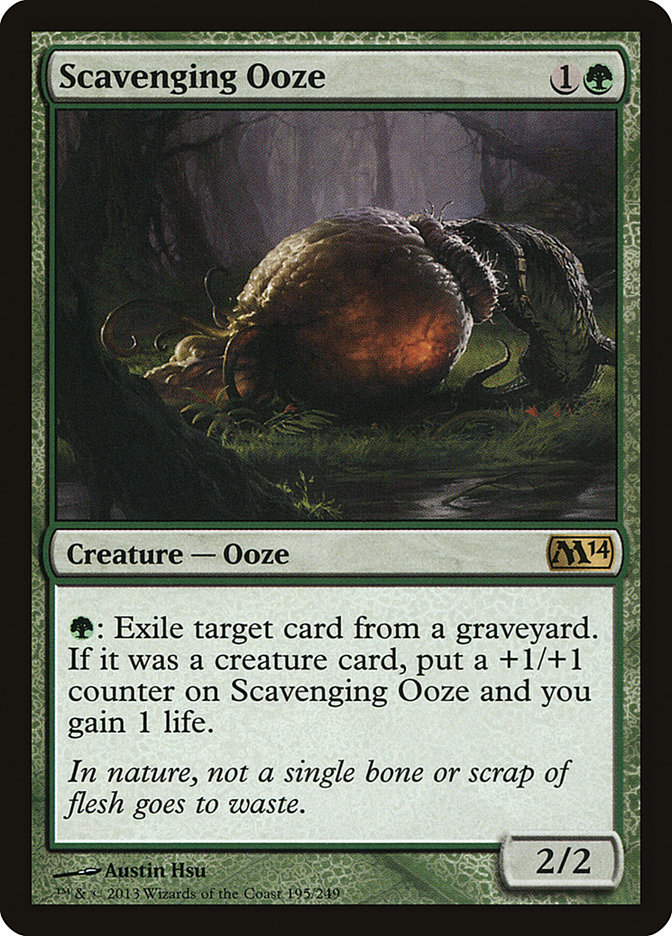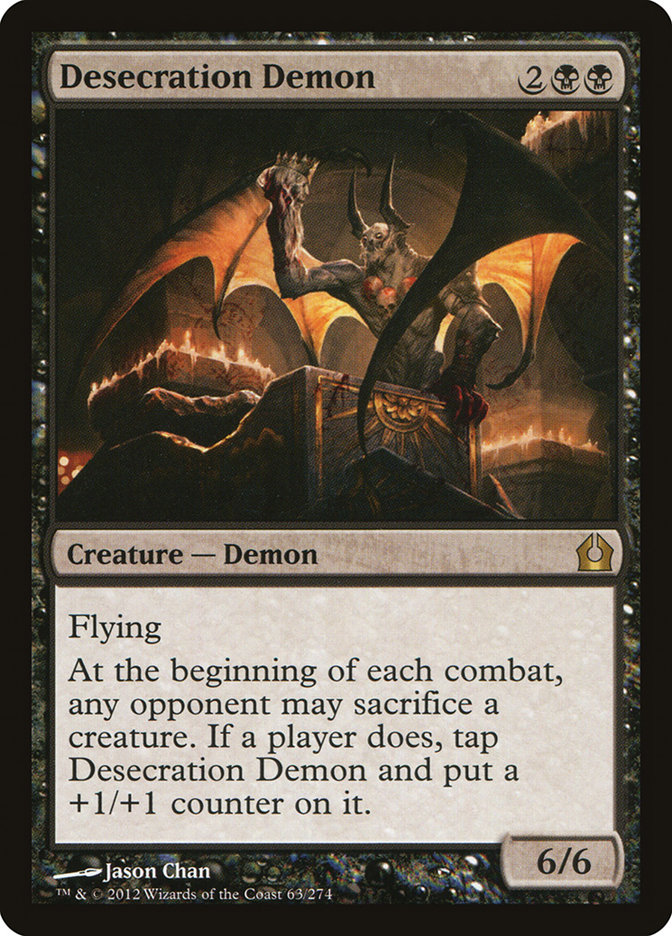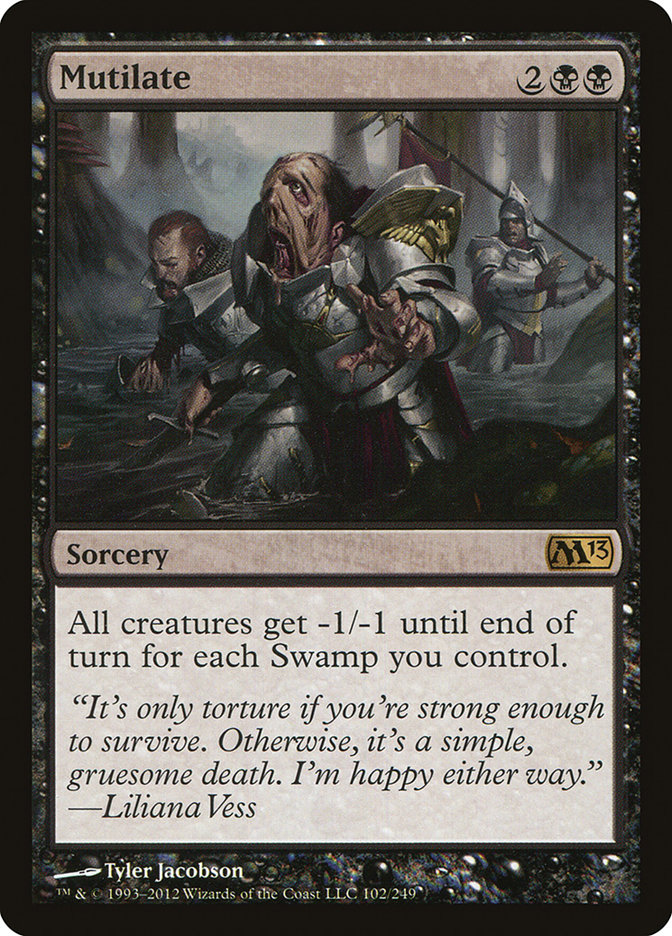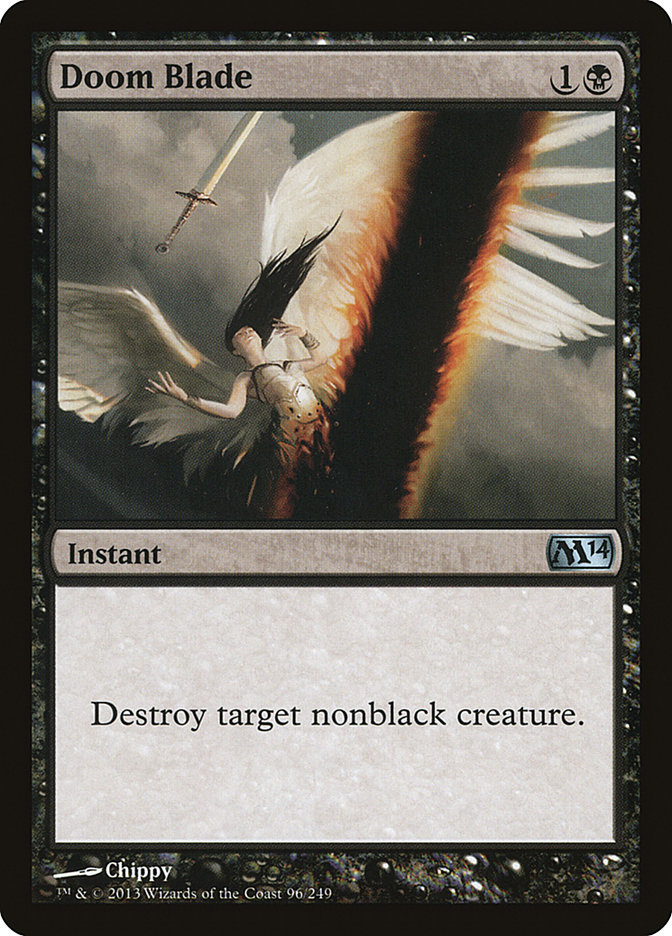The new number of the beast is 664: a 6/6 flying body for four mana. Desecration Demon is very powerful, but it lacked proper support until M14 came into Standard. New cards have made demon speeding acceptable and allowed it to become a powerhouse in our Standard format.
Let’s look at Jeff Hoogland list from the Top 8 of the StarCityGames.com Invitational in New Jersey. The first and most important question you should ask when looking at this list is "why this deck over Jund?" That’s always the question regarding semi-rogue decks. You don’t want to be different just to be different; the difference matters only if it gives you an advantage. Keep in mind that I don’t mean the advantage of opponents being unfamiliar with our decklist here, which is a common argument that I find highly overrated.
It works great if your deck is completely different from everything, but that’s rarely the case. Good opponents may still find ways to beat you by comparing your deck with existing analogues. So if you want to gain an edge with unfamiliarity, you’d better find some sweet sideboard tech for a well-known established deck that tries to build something different; this often leads to suboptimal card choices and glass hammers.
Creatures (17)
Planeswalkers (4)
Lands (25)
Spells (14)

So why this over Jund? This deck similarly utilizes great removal and powerful threats, but it’s a little bit more stable since its cards complement each other better. Jund has some matchups where you really need to have certain sequences of cards (like Farseek into Huntmaster of the Fells into Thragtusk) to beat an average draw from your opponent. This deck has fewer problems with this.
The second reason is Mutilate. It’s not Bonfire of the Damned; it’s a less powerful but more consistent version of one. You don’t need a miracle to get a one-sided wrath with Mutilate and Desecration Demon in play. Mutilate is also a much better early sweeper than a non-miracled Bonfire. A red sweeper for one is very relevant in this format full of mana dorks, but any pinpoint removal followed by Mutilate seems to be as devastating.
Mutilate seriously restricts the mana base, but this restriction also creates a significant advantage: invulnerability to Burning Earth. Burning Earth is still underplayed right now, but no one can argue its power against three-colored decks with two of the most popular choices among them. Burning Earth is an amazing plan to have against midrange decks for aggressive strategies. Furthermore, they usually don’t have an alternative plan of action, which gives B/G a huge advantage over Jund.
Another question is "why Jund over B/G?" First, card quality matters. Bonfire of the Damned is devastating, and there are enough decks that immediately concede when you untap with Olivia Voldaren. Second, Jund is a slight favorite against B/G, a deck that has a very hard time against U/W/R Flash. Jund has problems with U/W/R too, but they are far less significant.
Am I going to recommend you play a deck with bad matchups against the two most popular decks in the format? Not really. The Jund matchups is slightly unfavorable, but during my testing it took some time for the Jund pilot to figure out the best line of play—and that time was much more than one match. Moreover, there are ways to tweak the list and maximize our advantages, so I feel relatively confident in my Jund matchup against an average opponent. U/W/R Flash, however, is much worse, and it seems that it’s very hard to turn that matchup around without ruining the whole deck.
What do I dislike about Jeff Hoogland build of B/G Midrange? It’s extremely greedy. Three copies of Abrupt Decay mean that you badly need green mana on turn 2 and could have serious problems if you don’t hit one against an aggressive deck. How many green sources does Jeff have?
Ten.
That means he must mulligan a lot against aggressive strategies. Moreover, the one and only matchup where Abrupt Decay is better than Doom Blade is Bant Hexproof, and there you could still play Doom Blade plus Devour Flesh or Mutilate. In other matchups, Abrupt Decay over Doom Blade means that you can’t kill Hellrider, Thundermaw Hellkite, Huntmaster of the Fells, Restoration Angel, Thragtusk, and many more relevant threats.
Are there relevant black creatures vulnerable to Abrupt Decay? Cartel Aristocrat isn’t really vulnerable; Lifebane Zombie and Xathrid Necromancer will still trade favorably. Skirsdag High Priest is a fine reason but certainly not enough of one. Even if you’re deeply concerned with the Bant Hexproof matchup, three copies of Liliana of the Veil, Mutilate, and some copies Devour Flesh will be more than enough.
The second card I dislike in Jeff’s build is Scavenging Ooze. Ooze is a great card, but it simply doesn’t work as well as it should. Ooze is at its best in Jund due to that deck’s ability to feed it actively; it has enough removal, enough green mana sources, and enough time to spend mana activating it. Naya decks don’t have enough removal and time to activate Scavenging Ooze since they normally use all their mana while casting huge threats.
B/G has enough removal and enough time to activate Scavenging Ooze, but you often don’t hit your second green source early, so you can’t feed Scavenging Ooze effectively (especially if your ten-green build includes eleven non-Ooze green spells). Scavenging Ooze may be very effective in long games against midrange decks, but three maindeck copies are excessive for that purpose. Deathrite Shaman is probably as good a graveyard hate card against both Junk Reanimator and U/W/R Flash. Scavenging Ooze is a great beater if needed, but B/G often has enough time to take advantage of Deathrite Shaman.
 |
vs. |
 |
What could be done to improve the Jund matchup? I’ve noticed during testing that B/G has more cards than Jund and it’s hard to beat them without Garruk, Primal Hunter or a timely Rakdos’s Return. Card advantage matters in midrange mirrors, so Underworld Connections is great; you can easily play one or two maindeck in a Jund-heavy metagame. Sign in Blood is also fine and is of the most important cards of the deck, providing much-needed stability, but you never want to see two copies in your starting hand. Playing two copies is reasonable, but I’d increase your land count in that case.
Expensive enchantments are probably the hardest permanents to eliminate from the battlefield, so Deadbridge Chant and Primeval Bounty may be good for you too—at least until opponents start preparing for them. It seems a little bit strange to say "enchantments are invulnerable" in a format with a strong presence of Bant Hexproof, but Jund relies on sacrifice effects to beat them, while decks having access to Ray of Revelation will not side it in against you. That leaves Acidic Slime and Vraska the Unseen as the only legitimate threats once powerful enchantments hit the board. However, Brad Nelson has already mentioned Acidic Slime as a good sideboard option for Jund, so be aware!
The best anti-Jund strategy I figured out is to exploit our advantage in stability and then overpower Jund with card advantage; that means you need Duress post-board to dismember the opponent’s hand early—a turn 1 Duress into Farseek is so sweet—and probably something more reliable than Scavenging Ooze. Everyone quickly dismissed Geralf’s Messenger in favor of Lifebane Zombie, but the oldie is still fine against Jund (especially if you bother protecting it from Scavenging Ooze) and troublesome against U/W/R Flash. Drawing all your Zombies against mono-red will be terrible, but you must choose what you prefer. It’s clearly impossible to build a deck that beats everything. The question is how far you can go in hurting your good matchups.
A note to Jund players: you’re the aggressor in this matchup and should act accordingly. I didn’t have enough time to test this idea, but I’d try sideboarding Lifebane Zombie if you don’t have them maindeck because accidentally hitting a Thragtusk and providing some early pressure is more than fine. Aside from that, you should provide as much pressure as you can setting up your board for a lethal Bonfire of the Damned or Rakdos’s Return since the late game favors B/G.
A note to B/G players: after piloting Jund, the situation of winning with two burn spells divided by a few turns came up quite often. The second situation was death via Vraska’s ultimate (achievement unlocked), so I would say that B/G probably needs an additional finisher. Garruk Relentless is castable and able to provide a little stream of creatures, so he could be the one we need, but there’s another option.
I stated earlier that enchantments are hard to deal with in this format, so Demonic Rising may be a good choice. I don’t really like it since it’s slow and has relatively strong requirements (three Mutavaults maindeck to ensure you will produce Demons through removal), but there’s probably nothing better. The biggest concern regarding Garruk Relentless is Warleader’s Helix in U/W/R Flash, a card that can’t touch this demonic enchantment.
The U/W/R Flash matchup is a tricky one because you want to be the beatdown and win before the opponent can start chaining Sphinx’s Revelations. The problem is that the deck is bad in this role, and it’s hard to change. Your best chance to win is to disrupt their hand and find a finisher quickly. I’d sell a soul to Desecration Demon to be able to play Sin Collector in this deck, but all I have access to is Duress, so let’s work with what’s available.
Creatures (16)
Planeswalkers (4)
Lands (26)
Spells (14)

This list is more or less a traditional take on the archetype, with Demonic Rising as a plan against U/W/R Flash. Support for enchantments include Pithing Needle for Aetherling and a handful of Duresses. The anti-aggro package contains Vampire Nighthawk (which can be Tree of Redemption) and additional removal. Against midrange, you can side in a fourth Liliana of the Veil and Vraska the Unseen.
Creatures (17)
Planeswalkers (3)
Lands (25)
Spells (15)

This list is heavily suited for the Jund and U/W/R Flash matchups in other ways: Geralf’s Messenger, a pair of Underworld Connections maindeck, and a few sideboarded Garruk Relentless. Zombies are bad against red decks, so the sideboard contains Vampire Nighthawk supported by a few copies of Scavenging Ooze.
I’m not sure which version is better (probably a mix), but I think that the deck is a great metagame call for the next week (and I will very likely play it in Grand Prix Warsaw). Brian Kibler seemingly broke Standard with an amazing G/R deck (my backup for the Grand Prix) and seriously shook the field. A tuned aggro deck is a good matchup for B/G, especially when combined with the fact that G/R will likely press U/W/R Flash hard and shrink its presence in the field. Desecration Demon appreciates its little brother Hellrider’s work!
Good luck to everyone playing this weekend in the StarCityGames.com Open Series in Salt Lake City, Utah and the Classic Series in Albany, New York, and hopefully I’ll see some of you in the capital of Poland!





